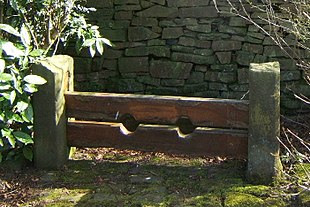
| Home | Title Index | Topic Index | Expert Directory | News Releases | Calendar | Articles |
Stocks
| This article needs additional citations for verification. Please help improve this article by adding reliable references. Unsourced material may be challenged and removed. (July 2009) |

Stocks are devices used in the medieval times for torture, public humiliation, and corporal punishment. The stocks partially immobilized its victims and they were often exposed in a public place such as the site of a market to the scorn of those who passed by. Since the purpose was to punish offenders against the standards of conduct of the time anybody could assault, revile or aim filth at the victim.
Contents |
[edit] Form and application
The stockade are similar to the pillory and the pranger, as each consists of large, hinged, wooden boards; the difference, however, is that when a person is placed in the stocks, their feet are locked in place, and sometimes as well their hands or head, or these may be chained.
With stocks, boards are placed around the legs or the wrists, whereas in the pillory they are placed around the arms and neck and fixed to a pole, and the victim stands. However, the terms can be confused, and many people refer to the pillory as the stocks.
Since stocks served an outdoor public form of punishment its victims were subjected to the daily and nightly weather. As a consequence it was not uncommon for people kept in stocks over several days to die from heat exhaustion or hypothermia.
The practice of using stocks continues to be cited as an example of torture, cruel and unusual punishment. Insulting, kicking, spitting and in some cases urinating and defecating on its victims could be applied at the free will of any of those present.
[edit] Historical uses
The stocks were popular among civil authorities from medieval to early modern times, and have also been used as punishment for military deserters or for dereliction of military duty. In the stocks, an offender's hands and head, or sometimes their ankles would be placed and locked through two or three holes in the center of a board. Either before or after this the wrongdoer might have his or her footwear removed, exposing their bare feet. Exhibiting an offender's bare feet was considered a form of humiliation. Offenders were forced to carry out their punishments in the rain, during the heat of summer, or in freezing weather, and generally would receive only bread and water, plus anything brought by their friends. Finger pillories often went by the name of "finger stocks". Public stocks were typically positioned in the most public place available, as public humiliation was a critical aspect of such punishment. Typically, a person condemned to the stocks was subjected to a variety of abuses, ranging from having refuse thrown at them, paddling, and tickling, to whipping of the unprotected feet - bastinado.
The stocks were used in Elizabethan England, and by the Puritans in the colonial period of American history. Their last recorded use in the United Kingdom was in 1872 at Adpar, Newcastle Emlyn, west Wales.[1]
The Spanish conquistadores introduced stocks as a popular form of punishment and humiliation against those that impeded the consolidation of their settlements in the new world. They were still used in the 19th century in Latin America to punish indigenous miners in many countries for rebelling against their bosses.
[edit] Examples
An excellent example of stocks can be seen in Dromore, County Down, in Northern Ireland. They are occasionally preserved in churches though as wooden devices they are naturally subject to the perils of rotting and decay.
Locations of examples in England and Wales include:
- Aldbury
- Apethorpe, Northamptonshire
- Chapel en le Frith
- Chapeltown, Lancashire
- Dunchurch, Warwickshire
- Fownhope, Herefordshire
- Grappenhall, Cheshire
- Kidwelly, Carmarthenshire
- Keevil, Wiltshire
- Lymm, Cheshire
- Nottingham
- Prestbury, Cheshire
- Seamer, North Yorkshire[disambiguation needed]
- Stow-on-the-Wold, Gloucestershire
[edit] See also
| Wikimedia Commons has media related to: Stocks (restraints) |
[edit] References
- ^ John May, Reference Wales (1994)
[edit] External links
|

